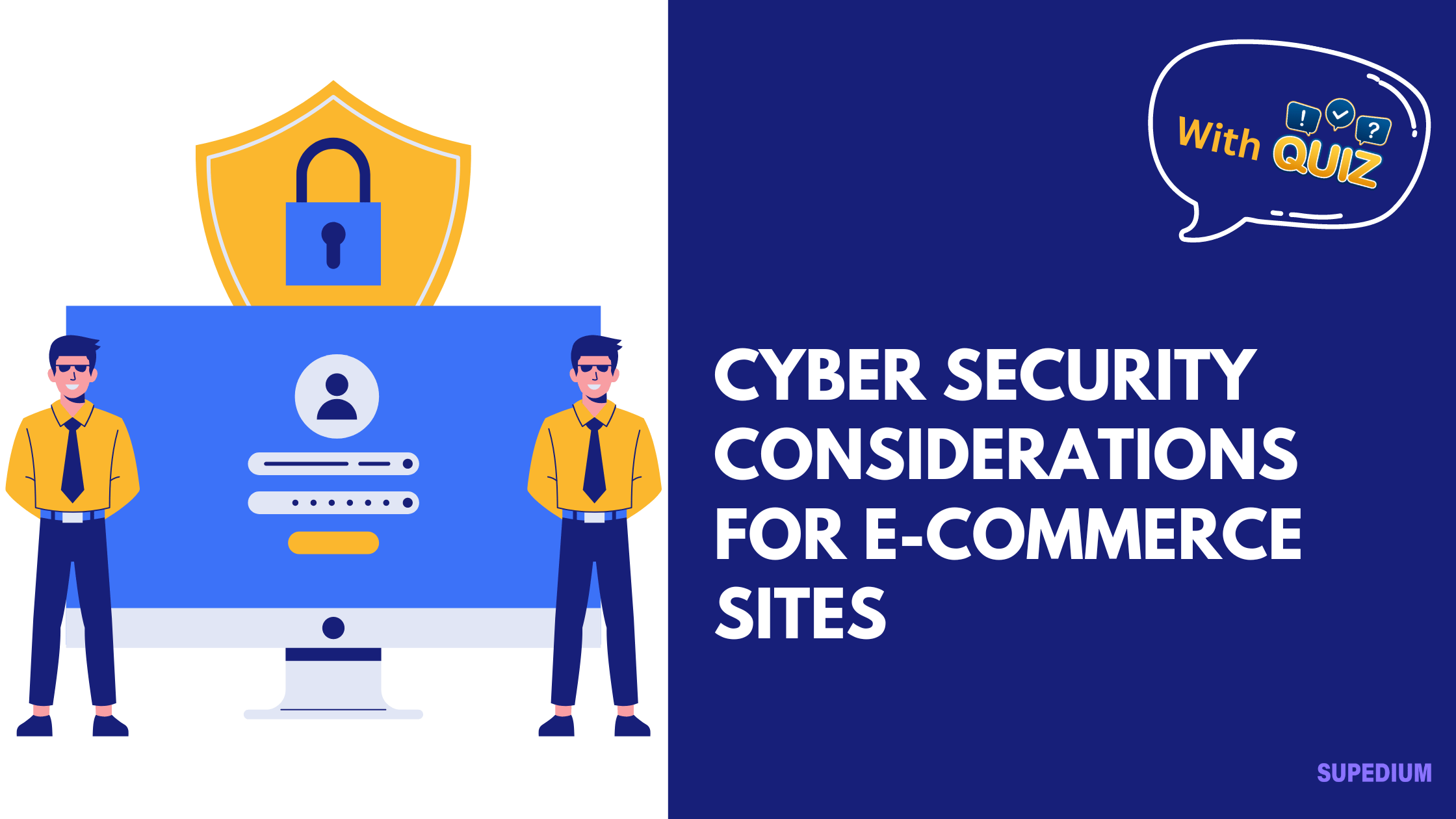Table of Contents
![]()
In an era where online shopping has become an integral part of daily life, ensuring the security of e-commerce sites is more crucial than ever. As the number of cyber threats continues to rise, e-commerce businesses must implement robust security measures to protect themselves and their customers. This article explores the various aspects of cyber security that are vital for e-commerce sites, including common threats, key security measures, data protection, monitoring, employee training, legal considerations, and emerging trends.
Types of Cyber Threats to E-commerce Sites
Malware and Ransomware
Malware, short for malicious software, encompasses a variety of harmful programs designed to damage or disrupt systems. Ransomware, a specific type of malware, encrypts a victim’s files and demands a ransom payment for their release. E-commerce sites are prime targets for such attacks due to the sensitive customer data they hold. Examples include the WannaCry ransomware attack, which affected thousands of organizations globally, including businesses in the e-commerce sector.
Phishing and Social Engineering
Phishing involves tricking individuals into divulging confidential information, often through deceptive emails or websites that appear legitimate. Social engineering extends beyond phishing, using manipulation to exploit human psychology for malicious purposes. For instance, attackers may pose as trusted figures within an organization to gain unauthorized access to systems or data.
DDoS (Distributed Denial of Service) Attacks
DDoS attacks overwhelm a website with excessive traffic, rendering it inaccessible to legitimate users. E-commerce sites are frequently targeted by such attacks to disrupt operations and damage reputations. An example is the 2017 attack on GitHub, which was one of the largest DDoS attacks ever recorded, highlighting the potential scale of these threats.
Data Breaches
Data breaches involve unauthorized access to sensitive data, such as payment information or personal details. The consequences can be severe, including financial loss, reputational damage, and legal ramifications. Notable breaches like the 2013 Target breach, where hackers stole credit card information of millions of customers, underscore the importance of robust data protection.
Man-in-the-Middle Attacks
In a man-in-the-middle (MitM) attack, an attacker intercepts and potentially alters communication between two parties. For e-commerce sites, this could mean intercepting payment details or other sensitive information during transmission, jeopardizing data integrity and customer trust.
Key Security Measures for E-commerce Sites
Secure Sockets Layer (SSL)/Transport Layer Security (TLS)
SSL and its successor, TLS, are protocols designed to secure data transmitted over the internet. Implementing SSL/TLS on e-commerce sites ensures that all data exchanged between the user and the website is encrypted, protecting it from interception and tampering. This is typically indicated by HTTPS in the URL and a padlock icon in the browser’s address bar.
Payment Security
Compliance with the Payment Card Industry Data Security Standard (PCI-DSS) is essential for handling payment information securely. This includes encrypting payment data and using tokenization to mask sensitive information. Regular audits and adherence to PCI-DSS guidelines help mitigate the risk of payment-related fraud and breaches.
Authentication and Authorization
Implementing multi-factor authentication (MFA) enhances security by requiring users to provide two or more verification factors before gaining access. Additionally, role-based access control (RBAC) ensures that individuals have access only to the data and systems necessary for their role, minimizing potential exposure.
Secure Coding Practices
Adhering to secure coding practices is crucial for preventing common vulnerabilities such as SQL injection and cross-site scripting (XSS). Input validation and data sanitization are key techniques to protect against these threats, ensuring that user inputs do not compromise the integrity of the system.
Regular Software Updates and Patching
Keeping software up-to-date is vital for addressing security vulnerabilities. Regular patching of both system and application software helps protect against known exploits. Implementing an effective patch management strategy ensures that updates are applied promptly and systematically.
Data Protection and Privacy
Data Encryption
Data encryption involves converting information into a secure format that can only be read by someone with the decryption key. Encryption in transit protects data as it travels over networks, while encryption at rest secures stored data. Both methods are essential for safeguarding sensitive customer information.
Privacy Policies and Compliance
E-commerce sites must adhere to privacy regulations such as the General Data Protection Regulation (GDPR) and the California Consumer Privacy Act (CCPA). Implementing and regularly updating privacy policies ensures compliance and helps build customer trust by demonstrating a commitment to data protection.
Data Backup and Recovery
Regular data backups are crucial for recovering from data loss incidents, whether due to cyber attacks or technical failures. Implementing a robust data backup strategy, including off-site or cloud-based backups, ensures that data can be restored quickly and efficiently in case of an emergency.
Monitoring and Incident Response
Continuous Monitoring
Ongoing monitoring of e-commerce sites helps detect and respond to security threats in real-time. Utilizing tools and techniques such as intrusion detection systems (IDS) and security information and event management (SIEM) solutions allows for the identification of anomalies and potential breaches.
Incident Response Planning
Developing a comprehensive incident response plan is essential for managing security incidents effectively. This includes outlining steps to take during an incident, such as isolating affected systems, communicating with stakeholders, and conducting a post-incident analysis to improve future responses.
Educating and Training Staff
Employee Training Programs
Training employees on cyber security best practices is crucial for minimizing human-related vulnerabilities. Training programs should cover topics such as recognizing phishing attempts, securely handling data, and responding to security incidents.
Creating a Security-Conscious Culture
Promoting a culture of security awareness within an organization encourages employees to adopt best practices and remain vigilant. Regular updates and refresher courses help keep security top of mind and ensure that employees are aware of the latest threats and mitigation strategies.
Legal and Regulatory Considerations
Understanding Legal Obligations
E-commerce sites must be aware of and comply with various laws and regulations governing data protection and cyber security. This includes understanding the legal implications of data breaches and ensuring that practices align with relevant legislation to avoid penalties.
Working with Legal Counsel
Engaging legal experts can help navigate the complexities of cyber security regulations and prepare for potential legal challenges. Legal counsel can assist in developing policies, responding to incidents, and ensuring compliance with applicable laws.
Future Trends and Emerging Threats
Advancements in Cyber Security Technology
Emerging technologies such as artificial intelligence (AI) and machine learning are increasingly being used to enhance cyber security. AI-driven tools can identify and respond to threats more efficiently, while blockchain technology offers potential benefits for secure transactions and data integrity.
Emerging Threats
As technology evolves, so do the threats. Staying informed about new types of cyber attacks and implementing proactive security measures are essential for maintaining protection. Emerging threats may include advanced persistent threats (APTs) and sophisticated social engineering tactics.
Conclusion
Ensuring the security of e-commerce sites is a multifaceted endeavor that involves understanding and addressing a range of cyber threats. By implementing robust security measures, protecting data, monitoring systems, training staff, and staying informed about emerging trends, e-commerce businesses can safeguard their operations and build trust with customers. Ongoing vigilance and adaptation are key to navigating the ever-evolving landscape of cyber security.






Be the first to comment